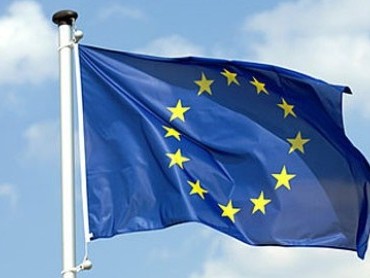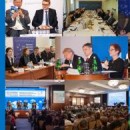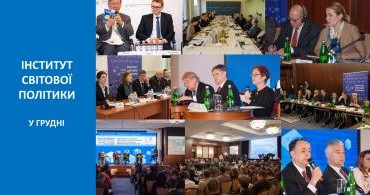By Alyona Getmanchuk, director of the Institute of World Policy for web brief of German Heinrich Boell Foundation.The European Union has had a number of opportunities to be in demand in the area, which, by inertia, is called a post-Soviet one. However, its chances in the past two years have definitely increased. There are many reasons for that.
The war in Georgia had urged a closer look to the east of the European Union by such respectful European politicians, who in the past used to direct their attention primarily to the south. The best evidence of such a correction of such an outlook was, of course, the launch of the Eastern Partnership.
The recognition of South Ossetia and Abkhazia not only created a precedent for violation of territorial integrity in the former Soviet Union area, but also, automatically, woke up the interest to other frozen conflicts in this region, specifically, Transnistria, where the EU is one of the negotiation parties in the format “5+2”.
An unsuccessful attempt by Ukraine and Georgia to significantly advance the membership in NATO helped create in some European Union capitals a new formula for neighbor countries in the east, known as “more EU, less NATO.” Moreover, the coming of the new political leadership to power in Ukraine forced Kyiv to totally re-direct all efforts exclusively to the side of the EU and to replace integration into NATO with a partnership. This is what the non-bloc status of Ukraine, recently fixed in a corresponding law. The new leadership of Moldova also declares the Euro-integrationist course. Even the name of its current coalition “For European Integration” reflects rather façade than reality.
Moreover, the enhanced new role of the European Union in the area of the former members of USSR is supported by a departure of the current administration of USA from active engagement into the issues of the region. In fact, there is another formula in action, “More EU, less USA.” The current American administration may find it as easy as never before to hang over the “post-Soviet area” file to the European Union. And only because the most uniting theme for Ukraine and Georgia in the tome of Bush administration, the integration into NATO, is off the agenda. But also because the main points of policy, which Washington conducts, are almost identical to those conducted by Brussels: non-recognition of any privileged interest zones of Russia, territorial integrity of Georgia, and withdrawal of Russian military bases from Moldova. The only difference is in wording: it is difficult to imagine the that the chancellor of Germany could have apply the word “occupation” so easily to Russia in South Ossetia and Abkhazia as state secretary Hillary Clinton has done during her recent visit to Tbilisi.
Could the European Union seize those opportunities to become a fully-fledged political player in countries of Eastern partnership? Including those, which relate to solving at least the most important for its security frozen conflicts?
Obviously, a lot depends on the extent, to which the European Union is considered a priority partner by a particular country to the east of the EU. Thus, what is the extent to which countries of the same Eastern Partnership are prepared to come forward to one or another initiatives on Brussels and be interested in strengthening its role in the region. Obviously, the counties, which declared multiple time their course to membership in the European Union, – such as Ukraine, Georgia, and Moldova -, have potentially a higher level of loyalty stock to engage Brussels.
However, not everything is so clear. Specifically, in the case of the leader of the Eastern Partnership, Ukraine. In Ukraine, for example, the issue of the EU member is no longer a priority agenda item to the degree it was during the rule of the previous government. For the European Union it means a new trend: in the dialogue with the EU, Ukraine will try and play not from a position of a potential candidate, but from a position of an equal business partner. Because if during the presidency of Yushchenko the EU was presented as some kind of a civilizational choice, then during the present pragmatic enough government, it is considered as rather a source of different financial flows. Therefore, the question posed by disgruntled European Union bureaucrats such as “who unites with whom?” will not produce any magical power. It is easy to grasp that, under the current leadership, the European Union will have a harder time conducting such initiatives in the Transnistria resolution, from which the new Ukrainian government, closely tied at all levels with business (especially the one that deals with the Transnistria region,) would not have benefit. Or, vice versa, would have had losses.
Instead, the new lever of influence for the European Union would be a new priority of the current Ukrainian administration on the path of European integration: elimination of the visa regime with the EU. For the Ukrainian president, this is an important electoral moment: if visas could be eliminated until the parliamentary elections in 2012 (and also until the football championship Euro-2012,) Yanukovych could have easily explained to the voters that his European integration indeeds differs from the European integration in words of the former president Viktor Yushchenko.
Generally, in Ukraine, (and also in some other countries of the European Partnership,) the European Union continues to be viewed as something amorphic and sensitive to the reaction of Russia. Consequently, a permanent question arises: why to negotiate anything with the European Union, if Russia would then be able to renegotiate with it everything as a result of friendship with Germany and France?
It is not difficult to predict that the European integration of Ukraine under the current leadership is indeed sensitive to the reaction of Russia and it will all the more often be synchronized with actions if the Russian government in the direction of the EU. The European Union should use to the full measure the fact that, at least until the introduction of a visa-free regime for both countries, the integration of Ukraine into the EU would not be an obstacle for Moscow.
Another new and important nuance: the new Ukrainian government would not pay as much attention to how Ukraine is identified in the European Union, as previous Ukrainian administration did.
It is not a secret that, for example, some time ago, a real storm of critics in Kyiv was produced by the European Neighborhood Policy. “We are not neighbors to Europe, we are neighbors to the European Union,” disgruntled Kyiv commentators were heard complaining. Later, Ukrainian diplomats and experts surprisingly shrugged shoulders when they knew that Germany insisted on classifying Ukraine a “European country” rather than a “European state” two years ago at the summit “Ukraine-EU” in Paris. In other words, preferred a geographic term without liabilities over a political one. Finally, before the launch of the European Partnership, Ukrainian diplomats were actively promoting in European Union capitals of the idea to name this initiative the “East European Partnership.” They said that Eastern Partnership could easily have included, along Ukraine, such countries as Turkmenistan or even China.
Despite all attempts by the previous Ukrainian government to prove to the Ukrainian population that Europe means also us, in the general Ukrainian discourse Europe is inseparably tied to the European Union. To some degree, one may greet the EU: its monopoly for the name “Europe” is increasingly become a fact on the territories of those countries only, whose elites continue to prove to the rest of the world the Europeanism of their counties. In addition to the fact, however politically incorrect the name “post-Soviet space” might be, it is still most clearly reflects the real situation prevailing in the majority of the countries to the east of the EU including Ukraine.
Considering that other countries of Eastern Partnership did not promote as actively as Ukraine did their right to a “membership prospective” and also generally appear in EU documents as a “European state,” it is possible to predict that the Eastern Partnership would be more easily re-oriented to solving specific issues. This also relates to solving the Transnistrian conflict, the one this is the closest one both to Kyiv and to Brussels.
Ukraine has always promoted a strengthened role of the European Union in the Transnistrian region. For Kyiv this is an issue of principle, because it is the only frozen conflict, which is located directly at its frontier. It is also the only conflict, where Ukraine plays a direct role of an intermediary and a guarantor of the resolution. Moreover, Transnistria is populated by some 100,000 Ukrainian citizens (and this is actually a third of the residents of the unrecognized republic.) In other world, if Kyiv used the logic of Moscow, then during any destabilization in the region, Ukraine could have intervened for protection of its compatriots, as Russian did in South Ossetia. Additionally, Transnistria is the only territory in the world, where the Ukrainian language is official, together with Moldovan and Russian languages.
It is not surprising that, in their time, Ukrainian diplomats applied maximal efforts to extend the format for resolution of the conflict as expense of the European Union and the USA. If not a support of Ukraine, the European Union would not have been able to complete its first real project on the territory of Moldova, EUBAM.
Ukraine is supporting with its both hands the efforts of the EU for strengthening trust between the two shores of Dniester, because it completely corresponds to the vision of how the conflict should develop: with the help of “Europeization” of not only directly Moldova, but also directly Transnistria. Along with that line, Kyiv is insisting that activities to strengthen trust be conducted independently from what happens at the negotiations “5+2.”
A positive step from the side of the European Union would be directing to Transnistria a direct, and not through Chisinau, EU assistance. It is important for Transnistrians to assure themselves that the attention to Transnistria and its resident is not limited only to the 15 American dollars in monthly bonus, which Russia adds to salaries and pensions of residents of the republic for years.
Worth praise are current attempts by the European Union to establish a rail connection between the capital of Transnistria, Tiraspol, and the Ukrainian port city, Odessa, which was stopped as long ago as in 2006. A result to this was that the road of 80 km began to take during summer up to seven hours for those who wanted to enter Transnistria from Ukraine.
At the same time, while engaging directly in actions to enhance trust, the EU should also hold a hand on the pulse of a political conflict resolution. In the past year, here we could also see some new tendencies. It is related to the change in government in both Moldova and Ukraine. A permanent political instability, related to the impotency to elect a new president in Moldova, has put away the realization of the Russian plan of a peaceful resolution, or the so-called Kozak-2 Plan, which envisages a federalization of Moldova, where Transnistria is an equal subject. However, at the moment of the former Moldovan president’s departure from power, Russia was close enough to transforming the “5+2” format into a “2+1” format (Moldova, Transnistria, and Russia,) to achieve in it the agreement based on the Russia scenario of a resolution. An important moment is that, after the recognition of independence of South Ossetia and Abkhazia, Russia is seriously focused on demonstrating to the whole world that it is capable of solving frozen conflicts not only using tanks but also a negotiation table. However, what it really demonstrated is double standards in resolving frozen conflicts in it’s “near aboard,’ which, of course, did not produce any special admiration in Transnistria.
What should the European Union take into account today? First, that, for Russia, any resolution of the Transnistrian conflict is possible only on the basis of its own plan. Any other initiatives are not acceptable for Moscow a priori. In order to have the whole world assured that the Russian version is much better than other possible options for the development of the situation in Transnistria, the press and expert community are fed by rumors of a merger of Moldova with Romania and a transfer of Transnistria to Ukraine.
A real blocking point to the Russian plan being approved is located in the Republic of Moldova, where the new leadership appears to be not really ready to implement Russian peacekeeping initiatives inside the de facto launched in the past year by Russia “2+1” format (Moldova, Transnistria, and Russia.) However, it cannot be ruled out that after the presidential and parliament elections in RM, Russian will try and find the right key to the new president of Moldova. It is also clear that, in order to not repeat the events of 2003 (when the Kozak Memorandum was prepared in a closed environment and was rejected at the last stage,) Russia will try and engage to the process either the EU or Ukraine (to actually create a “2+2” format.) Or even both the EU and Ukraine. It would be especially easy to agree with the later, considering the loyalty of the Ukrainian president to Russian international initiatives.
It is worth noting that Ukraine already, despite its vital interest to Transnistria, left the stage. The position of a special representative of Ukraine for the Transnistrian resolution is first for many years closed. This issue would be taken care of, most probably, by an ambassador for special tasks within the MFA of Ukraine, i.e. a diplomat of a lower rang.
It is difficult to imagine that Kyiv could, under the current government, clearly state its opposition to the Russian presence in Transnistria after when Viktor Yanukovych extended the location of the Russian Black Sea Fleet in Crimea until 2042. Now it is the EU who should demand from Russia the realization of the Istanbul agreements of 1999. And specifically German, whose unexpected desire to actively engage in Transnistrian crisis resolution has produced a big surprise in Ukrainian expert circles.
Second, the European Union should take in account the moment that Russia is far from all-powerful in solving the Transnistrian conflict. Its agreeing to that or other resolution scenario does not automatically mean that the re-integration of Moldova is taking place without any major problems. It is also important to take into account the presence of local level of the issue: the interest to maintain the status quo by a numerous group of businesses with ties in politics, which have direct benefit from the absence of a resolution of the conflict.
Third, the European Union should seriously work on developing its brand in Transnistria. Some its leaders are mixing the European Union with the Council of Europe, while many residents of the region perceive the European Union no different as a co-organizer of the “economic blockade” of the region (so was the name in Transnistria and Russia of the implementation of the new customs rules for crossing the Ukraine-Moldova border four years ago.) Branding of the European Union is also needed in other separatist regions on the “post-Soviet space,” and also in such a potentially dangerous region of Ukraine as Crimea. Information centers of the EU would be very appropriate. Also different study programs for students, young scientists and opinion makers from those regions.
Finally, the European Union should care against the impression in the countries of Eastern Partnership that it is only interested in regions, when there are conflicts on those territories. And, in order to attract a real attention from the European Union, it is necessary to make sure that such conflicts take place, be it a gas war between Ukraine and Russia, or the events such as those, which took place in Georgia.




Comments theme
Comments themeComments themeComments themeComments themeComments themeComments themeComments themeComments themeComments themeComments themeComments themeComments themeComments themeComments themeComments themeComments themeComments themeComments themeComments themeComments.